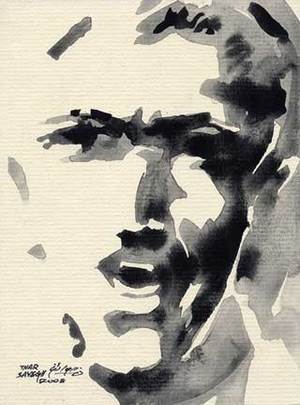This is an archive of the ArtCat Zine, 2007-2009. Please visit our new project, IDIOM.
"Freedom and Beauty" at St Paul the Apostle Church
Freedom and Beauty: The Art of Iraqi Refugees
St. Paul the Apostle - 405 W 59th St, New York NY
30 April - 28 May 2009
Everyone's talking about faith these days. In a recent issue of Commonweal, Terry Eagleton suggests that we ought to be attentive to the critical potentialities of religion; they are crucial, he thinks, because they provide an alternative to both radical fundamentalism and liberal-rationalist dogmatism. In a sense, it's easy to see what's at stake for him. Religion as a field of study now fills a niche once occupied by certain varieties of Marxism: it is, paradoxically, an ideologically uninvested space where adventurous approaches are welcomed rather than shunned. If its appropriations of Heidegger and Badiou are occasionally unrefined, it is because it's still something of a critical frontier.
The exhibition Freedom and Beauty: The Art of Iraqi Refugees, on view this month at St. Paul the Apostle Church, brings this frontier quality immediately to mind. Its engagement with theory, to be sure, is minimal. Nonetheless, the aggressive way in which it breaks with curatorial common sense is something of a statement in its own right. Paintings by four artists are arranged on a single display stand, crammed sardine-like into a few square feet. (Another artist is displayed on a slice of adjoining wall). The accompanying exposition in the press release and wall texts spends vanishingly little time on the paintings themselves. It focuses, rather, on the circumstances of their production, as even the title suggests. It describes the artists' experiences in war-torn Iraq and emigration, positioning the work itself as merely a response or an expression of the crisis — anything but l'art pour l'art.
But just as it makes little effort at any move towards something like contemporary exhibition practice, the exhibition also avoids making explicit political statements — it identifies neither culprits nor solutions — and, more strikingly, proselytizing. The objective seems to be the establishment of an interspace between traditionally ecclesiastical, artistic, and political sites and styles of dialogue. Though perhaps this is a grand claim for what is, after all, a fairly modest undertaking, its organizers are hardly strangers to such projects: the exhibition is the work of the Paulists, a missionary order that sees new media and cross-cultural exchange as fundamental to its evangelism. Freedom and Beauty, in short, represents a kind of religion even a Marxist like Eagleton can approve of. It is hard not to applaud the effort or appreciate its undermining of the borders between cultures and professions.
Yet a nagging doubt remains: what about the artists themselves? As far as the exhibition is concerned, they seem to be refugees first and artists only second. Their quotes are certainly reflective of the exhibition's liberal-humanitarian goal — but the same cannot be said of their paintings. It would, indeed, be a gross caricature to describe them unilaterally as responses to war and tragedy. Most are quiet, domestic scenes, boys with bicycles and flowers in vases. Even the many half-shrouded faces painted by Thar Sayegh are more likely to smile pensively than to scream in pain. Undoubtedly there is a special poignancy that the wartime context brings to the work, but all of the artists display complex dimensions that escape the way they are presented. Activists, Christians, and artists alike are bound to find something missing.
Like this exhibition, the kind of religion Eagleton seems to prefer is one that takes itself more seriously as a space than as a content. It may not represent the flabby last-man relativism he despises, but in its way it has just as little to offer. Fundamentalists and rationalists know what to die for; relativists don't care. Eagleton's theology can do neither; the totalizing claims of the thinkers he evokes far exceed the boundaries of this theology's self-understanding. And so it solves no one's problem, and does no one justice: it is a space for space's sake. “If we keep silent, we will die,” writes the artist Wassan Al Kabi on a plaque below a work, explaining her motives for painting. After the exhibition, a silence remains.
ZINE
HOME
TIPS / COMMENTS
CATEGORIES
CONTRIBUTORS
- Greg Afinogenov
- B. Blagojevic
- Adda Birnir
- Susannah Edelbaum
- Julie Fishkin
- Paddy Johnson
- Jessica Loudis
- Christopher Reiger
- Andrew Robinson
- Peter J. Russo
- Blythe Sheldon
- S.C.Squibb
- Hrag Vartanian

